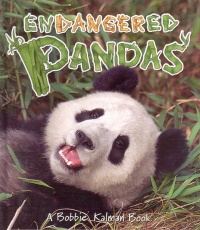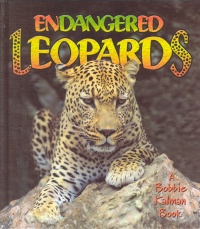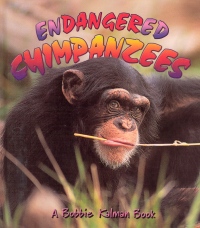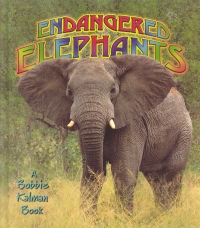| ________________
CM . . .
. Volume XII Number 4 . . . .October 14, 2005
excerpt:
In the continuing Crabtree series, "Earth's Endangered Animals," four new books present pandas, elephants, leopards and chimpanzees. These titles follow the familiar, well-balanced format established in the first seven volumes: introduction to the species and its habitat, habits and behaviour in the first 18 pages, with a discussion of threats from habitat loss and hunting as well as up to date details on conservation programs in the remaining 14 pages. Species information is highly readable for children in grades 2-5 with more difficult vocabulary in boldface type or defined in a brief glossary. Illustrations—photos and drawings—are generous, close-up and add considerable information in their captions. The main focus of the details on endangerment is habitat loss from human encroachment. Proximity to people contributes to the ease of illegal hunting or over-hunting which further reduces populations. Readers are told about preserves and sanctuaries and the way tourism dollars help with programs to protect remaining populations. Additional sources of information are provided in the bibliography of websites encouraging further investigation. Supporting the emphasis on education as the best route to helping endangered animals, each book in this series includes an interactive page with puzzles or activity suggestions. For example, can you differentiate between the colouration of a leopard, a jaguar and a cheetah? After learning about elephant "artists," can you create an art show of drawings or paintings about elephants and use them to fundraise for conservation programs? How about a card game based on panda trivia facts? These are activities that young readers can pursue in the interests of learning more about their chosen species. These attractive and easy to read books offer excellent opportunities for beginning researchers to gain an understanding of the complexity of nature. For example, shrinking panda habitat in China reduces the species population not only because of lack of space and food, but also because pandas can only find closely related partners, leading to inbreeding, possible disease and fewer cubs. In an attempt to interrupt this cycle of decline, tunnels and passages are being created to bypass obstacles like highways and villages (much like the wildlife overpasses in Banff's Bow Valley) to allow pandas to move between habitat areas. Readers may not have considered how war in African countries restricts similar movement of endangered elephants. The book also points out that some man-made "solutions" aren't necessarily the best: while elephants in captivity might appear to be well treated, they suffer from isolation from herd members in that unnatural environment. Each book has value as an introduction to a single species. Taken as a collection, it covers a wide range of species and conservation issues worldwide with enough diversity to appeal to all interests and to offer a broader picture to young readers of the critical state of the world's endangered animals. The series is worth placing on your library or home book shelves. Highly Recommended. A former teacher-librarian, Gillian Richardson, who lives in BC, is a freelance writer.
To comment
on this title or this review, send mail to cm@umanitoba.ca.
Copyright © the Manitoba Library Association. Reproduction for personal
use is permitted only if this copyright notice is maintained. Any
other reproduction is prohibited without permission.
NEXT REVIEW |
TABLE OF CONTENTS FOR THIS ISSUE
- October 14, 2005.
AUTHORS |
TITLES |
MEDIA REVIEWS |
PROFILES |
BACK ISSUES |
SEARCH |
CMARCHIVE |
HOME |



